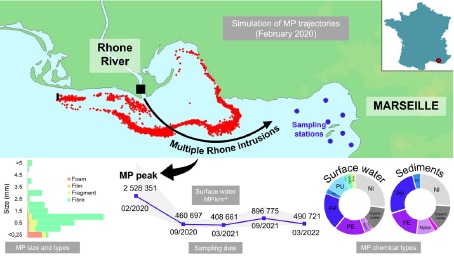Influence of the Rhone River intrusion on microplastic distribution in the Bay of Marseille, Alcaïno et al, 2024, Regional Studies in Marine Science
The ubiquitous contamination of environmental matrices by microplastics (MP) has recently emerged as a major societal issue. Despite a growing number of studies, their dispersion and accumulation dynamics remain largely undocumented. The need for quantitative data, with recurrent monitoring, is particularly crucial in the marine environment, to better estimate stocks and flows as well as the impact of currents on the dispersion of PM.
In this work, we studied PM contamination in surface water and sediments in the Bay of Marseille on a bi-annual basis from 2020 to 2022. Average concentrations of (5.79±12.71 MP.m-3) (9.13.105 MP.km–² ) were observed at the surface. No spatiotemporal trend was statistically demonstrated, except in February 2020 with an abnormally high PM concentration (22.47±8.85 MP.m-3 on average). These data indicate an average level of contamination comparable to those observed in surface waters over the last 10 years in the Bay of Marseille. Concentrations in sediments averaged 865±63 MP.kg-1 dry sediment.
The particles sampled in the water and sediments are mainly fibres (>65%) and are small in size (75% between 250µm and 1mm). The most abundant polymers are polypropylene (PP) and polyethylene (PE).
The data obtained in surface waters were combined with modelling results (MARS3D-ROHMA model) and Ichthyop software to study the Lagrangian transport of PM. We were able to show the influence of intrusions from the Rhône into the Bay of Marseille (linked to specific hydrometeorological conditions) and its impact on concentration levels in February 2020.

A collaboration between CEREGE, M.I.O. and ICTA (Barcelona)
A. Alcaïno (a), L. Vidal (a), L. Licari (a), C. Straws (a), S. Conrod (a), J. Dauvier (a), C. Chevalier (b), C. Pinazo (b), M. Grelaud (c), P. Ziveri (c,d)
a : Aix Marseille Univ, CNRS, IRD, CdF, INRAE, CEREGE, Aix en Provence, France
b : Aix Marseille University, University of Toulon, CNRS, IRD, MIO, Marseille, France
c : Institut de Ciencia i Tecnologia Ambientals (ICTA-UAB), Universitat Autonoma de Barcelona, Cerdanyola del Valles, Barcelona 08193, Spain
d : Catalan Institution for Research and Advanced Studies (ICREA), Barcelona, Spain


